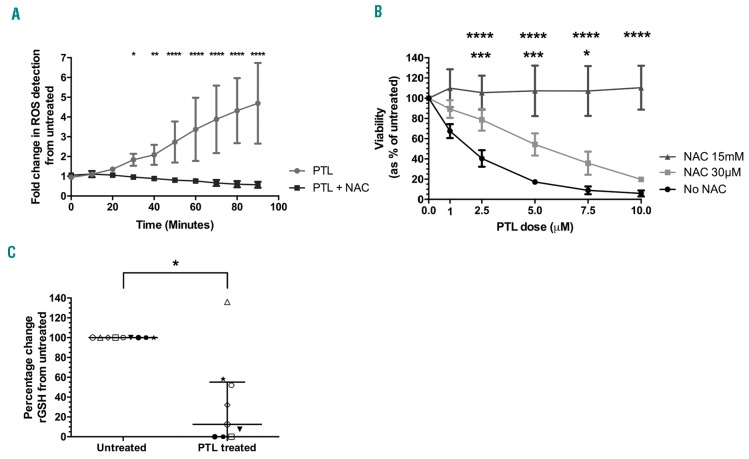Figure 1.
Parthenolide (PTL) induces changes in reactive oxygen species (ROS) and reduced glutathione (rGSH) levels can be reversed by N-acetyl cysteine (NAC). (A) T-cell acute lymphoblastic leukemia (T-ALL) samples (patients 1, 3, 5, and 9) were pre-incubated with the ROS sensitive probe CMH2DCFDA and ROS accumulation was measured in live cells over 90 minutes by flow cytometry in response to 10 μM PTL or with PTL+15 mM NAC. Fold change in median fluorescence intensity (MFI) compared to untreated cells is shown; data represent mean ± Standard Deviation (SD). Asterisks represent significant differences between PTL and PTL+15 mM NAC. (B) Dose response curve of patient samples 2, 5, 8, and 10 that had been treated with PTL only (1-10 μM), PTL+30 μM NAC, or PTL+15mM NAC; data represent mean±SD. Top row of asterisks represent significant differences between PTL alone versus PTL+15mM NAC; bottom row of asterisks represent significant differences between PTL alone versus PTL+30 μM NAC. (C) GSH levels were measured in T-ALL samples (patients 1-9) after treatment with PTL (10 μM) for 1 hour and compared with those in untreated cells. Symbols represent the mean % change from untreated cells in replicate samples. Each symbol represents an individual patient (see Online Supplementary Figure S1 for patient symbol key). Lines represent median and interquartile range. Results were analyzed by two-way ANOVA (A and B) or paired t-test (C). *P≤0.05, **P≤0.01, ***P≤0.001, ****P≤0.0001.

